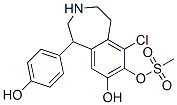Fenoldopam, first approved in the Netherlands in 1992, ended by
reaching its first market, the US, for the short-term management of severe
hypertension, including malignant hypertension, in the hospital setting.
Fenoldopam can be prepared in 3 steps from the corresponding phenethylamine
and aryloxiran, the pivotal step being the cyclisation in benzazepine in acidic
medium. Fenoldopam is a potent dopamine D1 receptor agonist acting
peripherally to produce systemic vasodilation.As it does not cross the bloodbrain
barrier, it does not exert significant central dopaminergic activity.
Fenoldopam also interacts significantly with 5HT1c and 5HT2 receptors. In
comparative trials with the most common drug used for this condition in Europe,
Fenoldopam was found to be appreciably more potent than nifedipine.
Furthermore, Fenoldopam is fast acting and maintains a long-lasting
antihypertensive effect.
Fenoldopam is an agonist of dopamine D1A (D1R) and D1B (D5R) receptors (Kds = 17 and 11 nM, respectively). Fenoldopam is used to study the roles of these receptors, in cells and in vivo, and to alter hemodynamic properties, including hypertension, in animals.
Fenoldopam mesylate may be used to study dopamine D1-mediated cell signaling.
antihypertensive, dopamine agonist
Dopamine D1-receptor agonist. Antihypertensive.
ChEBI: Fenoldopam mesylate is a benzazepine.
2-Chloro-3,4-dimethoxyphenethylamine (1.0 g) was reacted with 0.70 g of pmethoxystyrene
oxide to give the hydroxyphenethylamine; m.p. 118.5-121°C.
This compound (2.16 g) was stirred at room temperature in 15 ml of
trifluoroacetic acid with 4 drops of conc. sulfuric acid. After purification over a
silica gel column with chloroform, 10% methanol/chloroform as eluates, was
obtained 6-chloro-7,8-dimethoxy-1-p-methoxyphenyl-2,3,4,5-tetrahydro-1H-
3-benzazepine (0.78 g), m.p. 143-145°C.
The trimethoxy product (0.87 g, 2.50 mmoles) in 25 ml of dry methylene
chloride was cooled in an ice-methanol bath and 12.5 ml (25.0 mmoles) of
boron tribromide in methylene chloride was added dropwise. After stirring for
4 hours, the mixture was cooled in an ice bath while methanol was carefully
added to give 0.37 g of 6-chloro-7,8-dihydroxy-1-p-hydroxyphenyl-2,3,4,5-
tetrahydro-1H-3-benzazepine hydrobromide, m.p. 215°C.
The base was regenerated from the hydrobromide salt using sodium carbonate solution in 85% yield. Treating the base with various acids gave the
following salts: dl-tartrate, fumarate, hydrochloride, sulfate, and the most
water soluble one, the methanesulfonate, m.p. 272°C.
Fenoldopam mesylate (FM) is considered as an effective therapeutic agent to prevent the onset of postoperative AKI (PO-AKI). In healthy cats, FM can stimulate diuresis and be well-tolerated. This benzazepine-derivative is regional specific and does not cause cerebral vasodilation.

![8-Chloro-2-(4-hydroxyphenyl)-4-azabicyclo[5.4.0]undeca-7,9,11-triene-9,10-diol methanesulphonate pictures](https://img.chemicalbook.com/ProductImageEN/2018-12/Small/0d29a12c-2ca6-431a-b0b8-b91eca49647d.png)